To use Waterlilies, Impresssions and Soie Cristale, open the skein and
cut through the skein at the knot. You will have all one-yard lengths.
Use the number of strands or plies specified in the instructions.
INSTRUCTIONS
Start 3" down from the upper left corner of the canvas and
3 l/4" to the right with the Rhodes stitch at the top of the perfume
bottle.
AREA 1. Perfume Bottle Top. Use one strand of metallic throughout.
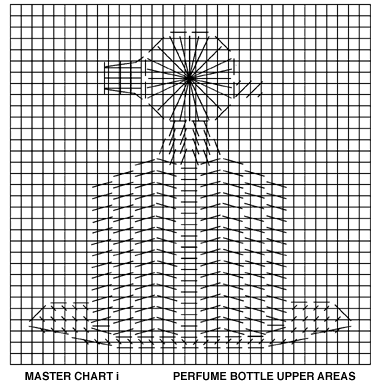
1. Rhodes stitch. The placement of the final stitch gives each particular
Rhodes its own personality and direction. Do backstitches around the Rhodes
as illustrated in the master chart.
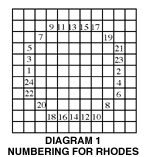
2. Spray Spout. Gobelin stitch tied down with vertical stitches.
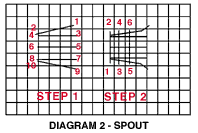
3. Connector to atomizer. Horizontal Cashmere -- see master chart above
4. Neck below Rhodes stitch. Vertical encroaching gobelin.
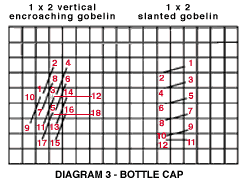
5. Bottle cap. Gobelin stitches. See Master Chart and Diagram 3. Work
in vertical rows, paying careful attention to the placement of the stitches.
Note that for the bottom stitches of the outer rows three stitches share
one hole.
6. Collar at base of cap. Diagonal tent surrounded by backstitches.
Note that the tent stitch changes direction for each side. The backstitches
will be whipped after the bottle has been stitched.
AREA 2. Perfume Bottle Upper Areas.
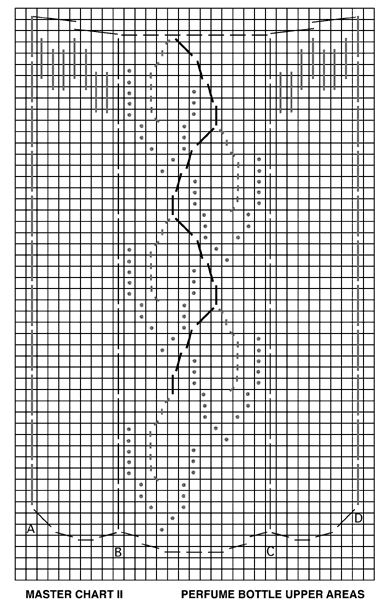
1. With one strand of metallic, work 2 rows of vertical "over 4"
backstitches to delineate the central area from the two side areas. When
the central area and 2 side areas are completed, whip these backstitches.
2. Thread your needle with 3 plies of Waterlilies in the following manner.
Cut the skein at the knot and strip off 3 plies from one length of thread.
Line up the variegations on two and turn the other strand opposite to create
a blend of colors.
3. Leaves, central area. With the Waterlilies stitch the 5 leaves in
the central area in the Free-form Fly Stitch.
a) A fly stitch is formed by leaving a straight stitch loose and tying
it down so that you form a "V".
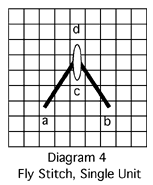
b) Follow the appropriate diagram to give either a right or left slant
to the leaf you are stitching. Begin with the bottom leaf. Stitch 1-2 is
a vertical straight stitch. Stitch 3-4, tied down by 5-6, is your first
fly stitch. As you bring your needle to the surface for stitch 5-6, pull
up and this action will give the fly stitch its proper shape and placement.
 4. Vine. With one strand
of Impressions, stitch the vine in whipped backstitch. First, work the
backstitches from top to bottom. When you reach the last backstitch, bring
your needle to the surface, sharing the hole at the bottom of the stitch.
Wrap by sliding the thread underneath each backstitch once. Begin at the
bottom and always approach the wrap from the same side and pull the thread
in the direction you are moving. When you reach the top of the vine, plunge
your needle to the back. This covers the segmentation of the backstitches
and creates a smooth unbroken curve. See Diagram 6.
4. Vine. With one strand
of Impressions, stitch the vine in whipped backstitch. First, work the
backstitches from top to bottom. When you reach the last backstitch, bring
your needle to the surface, sharing the hole at the bottom of the stitch.
Wrap by sliding the thread underneath each backstitch once. Begin at the
bottom and always approach the wrap from the same side and pull the thread
in the direction you are moving. When you reach the top of the vine, plunge
your needle to the back. This covers the segmentation of the backstitches
and creates a smooth unbroken curve. See Diagram 6.
5. Background behind vine and leaves. With 2 plies of Soie Cristale,
work the background in basketweave. The left side should be done in the
traditional slant. For the right side, reverse the slant of your stitches.
You may find it easier to turn the canvas one-quarter turn and work in
the traditional manner to achieve this.
6. Side sections, upper portion of bottle. With 3 plies of Waterlilies,
work the Florentine pattern from the top down on each side. The first full
row of each side is illustrated on the Master Chart. The compensation for
both the top and bottom of each side is charted for you on Diagram 7.
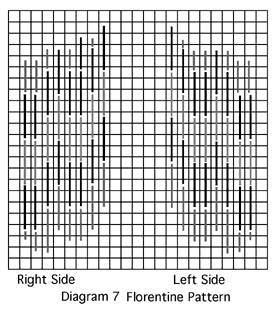
7. Division between upper and lower portions of bottle. Use metallic
thread for the scalloped row of whipped backstitch.
LOOK FOR PART II IN MAIN ONLINE CLASS PAGE
COPYRIGHT NOTICE: No part of these instructions nor the included designs/charts can be reproduced
or distributed in any form (including electronic) or used as a teaching
tool without the prior written permission of Anthony Minieri. One time
reproduction privileges provided to our web site visitors for and limited
to personal use only.

